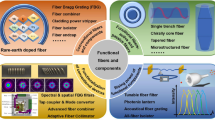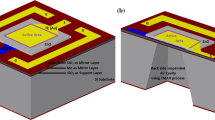Abstract
Fiber Bragg Gratings (FBGs) attract great attention due to their present and prospective applications in fiber-optical communication systems and modern opto-electronics. FBGs are components having a wide range of applications in the fields of communication, lasers and sensors. This study is a theoretical study in the field of FBG. Our aim is, by using coupled-mode theory and changing-of-index variation function, to model the FBG and to elucidate the appropriate parameters of FBG. Diffraction spectra of a FBG and its first and second degrees were obtained. Maximum reflection of FBGs versus saturation coefficient was also examined.
Similar content being viewed by others
References
Hill K.O. and Meltz G. (1997). Fiber Bragg gratings technology and overview. J. Lightwave Technol. 15: 1263–1276
Hill K.O., Fujii Y., Johnson D.C. and Kawasaki B.S. (1978). Photosensitivity in optical fiber waveguides: application to reflection filter fabrication. Appl. Phys. Lett. 32: 647–652
Hongzhi J. and Yulin L. (2000). First and second-order diffraction characteristics of fiber Bragg gratings. Opt. Comm. 178: 339–343
Kashyap R. (1999). Fiber Bragg Gratings. Academic Press, USA
Meltz G., Morey W.W. and Gleen W.H. (1989). Formation of Bragg Gratings in optical fiber by a transverse holographic method. Opt. Lett. 14: 823
Othonos A. and Kalli K. (1999). Fiber Bragg Gratings Fundamentals and Application in Telecommunications and Sensing. Artech House, Inc., London
Xie W.X., Dcuay M., Bernage P., Niay P., Bayon J.F. and Georges T. (1993). Second-order diffraction efficiency of Bragg gratings written within germanosilicate fibres. Opt. Comm. 101: 85–91
Zhao Y. and Palais J.C. (1997). Fiber Bragg grating coherence spectrum modelling, simulation and characteristics. J. Lightwave Technol. 15: 154–161
Author information
Authors and Affiliations
Corresponding author
Rights and permissions
About this article
Cite this article
Kurtaran, S., Kılıçkaya, M.S. The modelling of Fiber Bragg Grating. Opt Quant Electron 39, 643–650 (2007). https://doi.org/10.1007/s11082-007-9117-1
Received:
Accepted:
Published:
Issue Date:
DOI: https://doi.org/10.1007/s11082-007-9117-1




